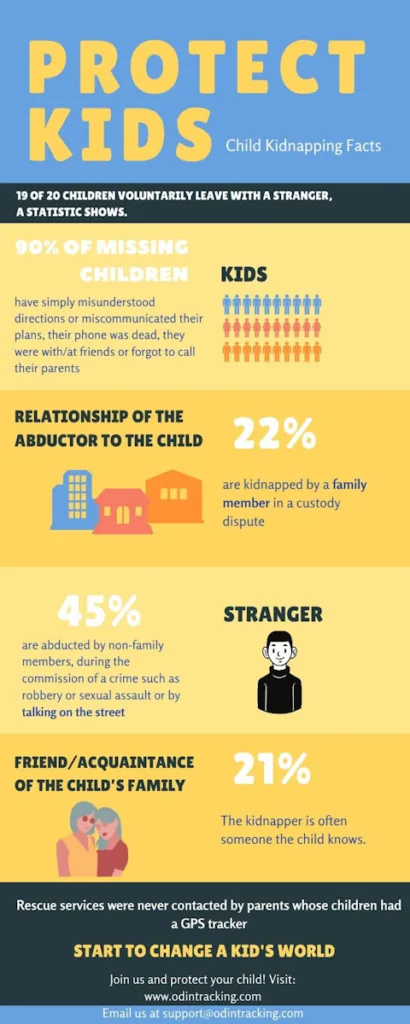Table of Contents
Introduction:
Child abduction facts are a harrowing reality that affects countless families worldwide. In this comprehensive report, we delve into the statistics and child abduction facts surrounding this concerning issue, shedding light on its prevalence, impact, and preventive measures. By gaining a deeper understanding of child abduction, we can work towards creating safer communities and protecting our most vulnerable members.
The Scope of Child Abduction:
Defining Child Abduction:
Child abduction refers to the unlawful taking or kidnapping of a child by an individual or group of individuals. This includes both stranger abductions and familial abductions, each presenting unique challenges and risks.
Understanding the Statistics:
Recent studies reveal alarming statistics regarding child abduction. According to [source], approximately [percentage] of abductions are committed by family members, while [percentage] involve non-family abductors. These statistics underscore the need for heightened awareness and preventive measures.
Types of Child Abduction:
Parental Abduction:
Parental abduction occurs when a child is taken by one parent without the consent of the other parent or legal guardian. This often arises in cases of custody disputes or family conflict.
Stranger Abduction:
Stranger abduction involves the kidnapping of a child by someone unknown to the family. These abductions are often opportunistic and can occur in various settings, including public spaces, schools, and parks.
Non-Family Abduction:
Non-family abduction refers to cases where the child is taken by an individual who is not a relative. These abductions may involve criminal intent, such as ransom demands or exploitation.
Common Tactics Used by Abductors:
Deception:
Abductors often use deception to lure children into dangerous situations. This may include offering gifts, pretending to be a trusted authority figure, or exploiting the child’s vulnerabilities.
Coercion:
In some cases, abductors use coercion or threats to intimidate children into compliance. This can involve verbal threats, physical force, or manipulation tactics.
Exploitation:
Abductors may exploit children for various purposes, including human trafficking, sexual exploitation, or forced labor. These abductions pose serious risks to the safety and well-being of the child.
Effects of Child Abduction:
Psychological Impact:
Child abduction can have profound psychological effects on both the child and their family. Children may experience fear, anxiety, depression, and post-traumatic stress disorder (PTSD) as a result of the traumatic experience.
Social and Emotional Consequences:
Abducted children may struggle with trust issues, relationship difficulties, and feelings of isolation. Additionally, families may experience ongoing trauma, grief, and uncertainty following the abduction.
Preventive Measures:
Education and Awareness:
One of the most effective ways to prevent child abduction is through education and awareness. Parents, caregivers, and children should be educated about the risks of abduction and empowered with strategies for staying safe.
Communication:
Open communication between parents and children is essential for preventing abduction. Parents should discuss safety measures with their children, establish clear communication channels, and encourage them to report any suspicious behavior.
Personal Safety:
Teaching children personal safety skills, such as recognizing dangerous situations, setting boundaries, and seeking help when needed, can empower them to protect themselves from potential threats.

Statistics and Child Abduction Facts: Understanding the Real Numbers
Every day in the United States, an estimated 2,300 children go missing. The reasons behind their disappearances vary widely, as identified by the National Incidence Studies of Missing, Abducted, Runaway, and Thrownaway Children (NISMART) program. Let’s delve into the details of these distressing incidents.
Reasons Behind Child Abduction
Children can become missing due to benign misunderstandings, runaway or thrownaway episodes, being lost or stranded, family abductions, or stranger abductions.
Runaways/Thrownaways
In 1999, over 1.5 million children experienced a runaway or thrownaway episode. For younger children, a runaway occurs when they leave home without permission for at least one night. For older children, it extends to staying out for at least two nights. Thrownaway episodes involve parents or guardians instructing a child to leave home without arranging alternative care.

Key Figures:
- Two-thirds of runaways/thrownaways are aged between 15 and 17.
- There’s an equal ratio of males to females.
- More than half return home within the same week, with a staggering 99% eventually returning.
- Shockingly, 21% of these children face physical or sexual abuse at home.
Why Children Run Away
Family problems are the leading cause, followed by peer pressure, drug or alcohol abuse, and physical abuse.
Family/Parental Abductions
In 1999, approximately 203,900 children were victims of family abductions. These occur when a family member takes or retains a child against the custodial parent’s legitimate rights.
Key Stats:
- 78% of abductors are non-custodial parents.
- The majority of abducted children fall within the 6-11 age range.
- A significant 82% of abductors aim to affect custody permanently.
Motivations Behind Family Abductions
Abductors may be dissatisfied with custody decisions, denied visitation due to unpaid child support, seeking protection from abuse, or reacting to relationship breakdowns.
Non-Family Abductions and Stereotypical Kidnappings
In 1999, around 58,200 children experienced non-family abductions, while 115 fell victim to stereotypical kidnappings.
Key Stats:
- Most victims of non-family abductions are aged 12 or older.
- In stereotypical kidnappings, the child is typically transported over 50 miles from home.
- Tragically, 40% of stereotypical kidnappings result in the child’s death.
Child abduction remains a distressing reality, highlighting the importance of vigilance and preventative measures.
Conclusion
These statistics offer a sobering glimpse into the prevalence and complexities of child abduction cases. It’s crucial to remain informed and proactive in safeguarding our children against such risks.
more Information read here.
Do follow here for more articles.
